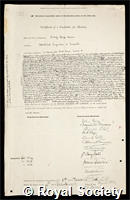| RefNo | EC/1916/08 |
| Previous numbers | Cert XIII, 101; A00949 |
| Level | Item |
| Title | Brown, Sidney George: certificate of election to the Royal Society |
| Description | Date stamp on reverse |
| Citation | Electrical Engineer and Inventor. Author of Papers read before the Institution of Electrical Engineers (1902) on his submarine relay, used by all the cables in the world, and the telephone relay, of great use in wireless telegraphy (1910). These two papers gained Fahie premiums. 'Modern Submarine Telegraphy' (Roy Inst, 1909); 'Magnifying Feeble Currents and other Inventions' (Phys Soc, 1912); 'The Production of Rapidly Alternating Current between a Copper Block and a Rotating Aluminium Disc' (The Electrician); 'Reverse Action of the Wehnelt Electric Interrupter' (ibid). Some of the following inventions are described in the above papers and in ordinary text books: - Drum cable relay with magnetic shunt and local corrections which first relayed messages from long cables ('see' article 'Telegraph' in Ency Brit) in which Brown's interpolator and his thermoelectric relay are also described. Discovered method of stopping sparking in dynamos. Experimenting with Sir Henry Hozier discovered method of directing Herz waves, first by two elevated wires placed half a wave length apart, second by a reflector composed of wire netting. Such a reflector 14 feet high enabled signalling to be made over a distance of 14 miles in 1899. In 1903 discovered the first dry wireless detector (composed of a lead or thallium anode and a platinum cathode); in 1908 the single point iridium microphone relay which first magnified inaudible telephone current (use in telephone transmitters of this material, 1910); the carbon telephone relay; (1911) Syphon recorder which increased speed of signalling by 20 per cent; Granular carbon microphone relay for telephone lines with electric regulators magnifying currents 20 times with clear articulation; (1912) Simplex switching, whereby it is for the first time possible to use a relay in the middle of a telephone line speaking both ways. This is a quite new departure in telephony, and by means of it conversation can be carried out at any distance; (1910) Telephone receiver using magnet and steel reed operating a cone of aluminium instead of a magnetic diaphragm. It is exceedingly sensitive and is greatly in use in wireless telegraphy; (1911) A method of getting good quality of sound and speech articulation in a gramophone, using an aluminium cone; (1910) An electrical stethoscope enabling the beats of the human heart to be heard out in the room; tested at the London Hospital. On one occasion five physicians in the Isle of Wight studied the heartbeats of a patient in London, electric transmission occuring through the ordinary telephone wires of the post office; (1912) A loud speaking telephone receiver by which the voice is transmitted with great clearness into a room; (1901 to 1908) Discovered various methods of correcting defects of transmissionin cables; (1911) A mechanical relay which varying forces exerted by a silk fibre are magnified enormously, the amounts of motion remaining unaltered; (1913) Methods by which for the first time airships and aeroplanes can receive wireless messages. These are now in use by the Government Flying Corps. Messages have been read in an areoplane from an ordinary field at 120 miles distant at an elevation of 2 000 feet. The messages are read by ear or by a flash lamp; (1910) Discovered several interesting phenomena in sound, notably the elimination of the nasal effects produced by funnels. Also the great magnification of sound passing along a glass rod when the rod terminates in a large, very thin bulb; (1906) Improved the efficiency of the aluminium rectifier for alternating currents by making a pole of copper touch the wet aluminium face of the other pole; (1905) The stimulation of oxidation and other chemical actions by the (catalytic?) action of alternating currents of extremely high frequency; (1908) When receiving currents of all sorts of frequency in submarine signalling, a method of sending currents of only one frequency through the telephone and shunting the other currents. An alternator of very high frequency; (1909) Discovered methods which enable very deaf people to hear clearly, in some csases using the teeth; and many other inventions. |
| Proposers | J Perry; [Joseph W Swan]; D Clerk; C V Boys; [David Gill]; S P Thompson; A Liversidge; G C Foster; William Ramsay; James Dewar; J Norman Lockyer; John Wolfe Barry; R T Glazebrook; D Clerk; H McLeod; Charles A Parsons; Henry Jackson |
| AccessStatus | Open |
| Image | 
|
Fellows associated with this archive
| Code | PersonName | Dates |
| NA6949 | Brown; Sidney George (1873 - 1948) | 1873 - 1948 |